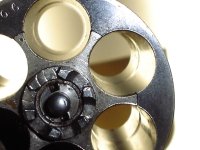stanmerrell
Member
Well, mystery is finally solved. Turns out to be a happy ending too. 44-40. Serial numbers all match. None on the cylinder though. Not sure why. There is end play and I'm wondering if it can be taken out by a smith? b/c gap is decent. Seller was from Michigan, but could not learn anything about him. All in all very pleased. Look forward to any thoughts and comment.






Last edited:







